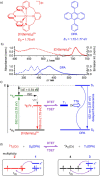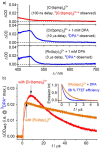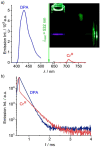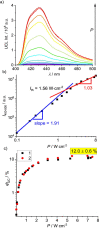Efficient Triplet-Triplet Annihilation Upconversion Sensitized by a Chromium(III) Complex via an Underexplored Energy Transfer Mechanism
- PMID: 35344256
- PMCID: PMC9322448
- DOI: 10.1002/anie.202202238
Efficient Triplet-Triplet Annihilation Upconversion Sensitized by a Chromium(III) Complex via an Underexplored Energy Transfer Mechanism
Abstract
Sensitized triplet-triplet annihilation upconversion (sTTA-UC) mainly relies on precious metal complexes thanks to their high intersystem crossing (ISC) efficiencies, excited state energies, and lifetimes, while complexes of abundant first-row transition metals are only rarely utilized and with often moderate UC quantum yields. [Cr(bpmp)2 ]3+ (bpmp=2,6-bis(2-pyridylmethyl)pyridine) containing earth-abundant chromium possesses an absorption band suitable for green light excitation, a doublet excited state energy matching the triplet energy of 9,10-diphenyl anthracene (DPA), a close to millisecond excited state lifetime, and high photostability. Combined ISC and doublet-triplet energy transfer from excited [Cr(bpmp)2 ]3+ to DPA gives 3 DPA with close-to-unity quantum yield. TTA of 3 DPA furnishes green-to-blue UC with a quantum yield of 12.0 % (close to the theoretical maximum). Sterically less-hindered anthracenes undergo a [4+4] cycloaddition with [Cr(bpmp)2 ]3+ and green light.
Keywords: Chromium; Dexter Energy Transfer; Doublet-Triplet Energy Transfer; Triplet-Triplet Annihilation; Upconversion.
© 2022 The Authors. Angewandte Chemie International Edition published by Wiley-VCH GmbH.
Conflict of interest statement
The authors declare no conflict of interest.
Figures




Similar articles
-
First-Row d6 Metal Complex Enables Photon Upconversion and Initiates Blue Light-Dependent Polymerization with Red Light.Angew Chem Int Ed Engl. 2023 Oct 23;62(43):e202311470. doi: 10.1002/anie.202311470. Epub 2023 Sep 18. Angew Chem Int Ed Engl. 2023. PMID: 37681516
-
Enhancing Triplet-Triplet Annihilation Upconversion: From Molecular Design to Present Applications.Acc Chem Res. 2022 Sep 20;55(18):2604-2615. doi: 10.1021/acs.accounts.2c00307. Epub 2022 Sep 8. Acc Chem Res. 2022. PMID: 36074952
-
Pd-Porphyrin Oligomers Sensitized for Green-to-Blue Photon Upconversion: The More the Better?Chemistry. 2016 Jun 13;22(25):8654-62. doi: 10.1002/chem.201504498. Epub 2016 May 3. Chemistry. 2016. PMID: 27143644
-
Photon upconversion sensitized by earth-abundant transition metal complexes.Phys Chem Chem Phys. 2025 Jul 2;27(26):13793-13811. doi: 10.1039/d5cp00333d. Phys Chem Chem Phys. 2025. PMID: 40539860 Review.
-
Triplet-triplet annihilation-based photon upconversion using nanoparticles and nanoclusters.Mater Horiz. 2024 May 20;11(10):2304-2322. doi: 10.1039/d4mh00117f. Mater Horiz. 2024. PMID: 38587491 Review.
Cited by
-
Pushing the Thermodynamic and Kinetic Limits of Near-Infrared Emissive CrIII Complexes in Photocatalysis.J Am Chem Soc. 2025 Aug 6;147(31):28226-28240. doi: 10.1021/jacs.5c08541. Epub 2025 Jul 28. J Am Chem Soc. 2025. PMID: 40720722 Free PMC article.
-
Shedding Light on the Oxidizing Properties of Spin-Flip Excited States in a CrIII Polypyridine Complex and Their Use in Photoredox Catalysis.J Am Chem Soc. 2022 Aug 10;144(31):14181-14194. doi: 10.1021/jacs.2c04465. Epub 2022 Aug 1. J Am Chem Soc. 2022. PMID: 35913126 Free PMC article.
-
Tuning Excited State Character in Iridium(III) Photosensitizers and Its Influence on TTA-UC.Inorg Chem. 2024 May 27;63(21):9931-9940. doi: 10.1021/acs.inorgchem.4c01003. Epub 2024 May 13. Inorg Chem. 2024. PMID: 38738860 Free PMC article.
-
Bridge editing of spin-flip emitters gives insight into excited state energies and dynamics.Chem Sci. 2024 Nov 11;15(48):20251-20262. doi: 10.1039/d4sc05860g. eCollection 2024 Dec 11. Chem Sci. 2024. PMID: 39568889 Free PMC article.
-
Luminescent Fe(III) Complex Sensitizes Aerobic Photon Upconversion and Initiates Photocatalytic Radical Polymerization.J Am Chem Soc. 2024 Dec 25;146(51):35390-35401. doi: 10.1021/jacs.4c14248. Epub 2024 Dec 10. J Am Chem Soc. 2024. PMID: 39658028 Free PMC article.
References
-
- None
-
- Parker C. A., Hatchard C. G., Proc. R. Soc. London Ser. A 1962, 269, 574–584;
-
- Parker C. A., Hatchard C. G., Proc. Chem. Soc. London 1962, 386–387;
-
- Parker C. A., Hatchard C. G., Joyce T. A., Nature 1965, 205, 1282–1284;
-
- Bharmoria P., Bildirir H., Moth-Poulsen K., Chem. Soc. Rev. 2020, 49, 6529–6554; - PubMed
Grants and funding
LinkOut - more resources
Full Text Sources
Miscellaneous

